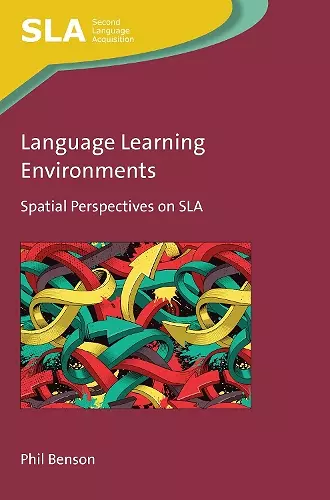Language Learning Environments
Spatial Perspectives on SLA
Format:Hardback
Publisher:Multilingual Matters
Published:4th Jun '21
Currently unavailable, and unfortunately no date known when it will be back
This hardback is available in another edition too:
- Paperback£27.95(9781788924894)

The first single-authored book on space and place in SLA written by a leading researcher in the field
This book is the first in-depth examination of the application of theories of space to issues of second language learning. The author outlines a new conceptual framework for researching SLA that centres on the idea of 'language learning environments' and demonstrates that where people learn languages is equally as important as how they do so.
This book is the first in-depth examination of the application of theories of space to issues of second language learning. The author introduces the work of key thinkers on the theory of space and place and the relevance of their ideas to second language acquisition (SLA). He also outlines a new conceptual framework and set of terms for researching SLA that centre on the idea of 'language learning environments'. The book considers the spatial contexts in which language learning takes place and investigates how these spatial contexts are transformed into individualised language learning environments, as learners engage with a range of human and nonhuman, and physical and nonphysical, resources in their daily lives. Revisiting linguistics and language learning theory from a spatial perspective, the book demonstrates that the question of where people learn languages is equally as important as that of how they do so. This work is essential reading for any researcher wishing to research the role of the environment as an active player in SLA.
There are those rare works that challenge and transform your thinking about the world and our place in it – this is one of those amazing books. Benson manages to call into question many assumptions and blind spots within SLA and creates new vistas for comprehending the composition and conceptualisation of language learning environments. This truly is an erudite and transformational read. * Sarah Mercer, University of Graz, Austria *
Benson offers us a fascinating account, contrasting a linguistic view of language as comprised of self-contained objects in space with an integrated environmental view of language as space. Where second language learning takes place makes a difference – an important lesson for SLA researchers to heed. Be prepared to have your mind stretched. Mine was. * Diane Larsen-Freeman, Professor Emerita, University of Michigan, USA *
In this book, Phil Benson takes us on a stimulating journey through the spatial dimensions of language, language learning, linguistics and second language acquisition research. In the process we view language learning environments through a range of transdisciplinary lenses, including spatial theory, globalisation, and multilingualism. A valuable contribution to scholarship on the spatial turn in applied linguistics! * Terry Lamb, University of Westminster, UK *
Destined for libraries and the collections of established researchers, Bensons' book should also find its way onto the reading lists of graduate courses where hopefully it will inspire a new generation of researchers to pursue unprecedented lines of inquiry.
-- Garold Murray, Independent Researcher, Japan * IATEFL Independence, Issue 82 *There is no doubt that this volume treads new ground and advances a coherent framework for researching and analysing the spatiality of language and language learning environments. My students can now thank (blame?) Professor Benson when I invite them to make clear how all objects, human and non-human, interact in the spaces they inhabit and to define their specific meaning of the “learning environment.”
-- Vincent Greenier, University of Aberdeen, UK * Iranian Journal of Language Teaching Research 9(3), (Oct., 2021) *This is a valuable reading for any scholar wishing to account better for the ‘where’ of language learning. Benson does a very good job of communicating his view on the spatial dimensions of language, language learning, linguistics, and second language acquisition research.
-- Yevheniia Hasai, University of Hamburg, Germany * LINGUIST List 33.1819 *For readers coming from a multimodal, social semiotic perspective, reading Language Learning Environments
can be a disconcerting yet enlightening experience. Aside from brief references to familiar approaches
like conversation analysis, the theories of space that Benson (2021) applies have not been dealt with substantially
in social semiotics.
ISBN: 9781788924900
Dimensions: 234mm x 156mm x 13mm
Weight: 398g
168 pages